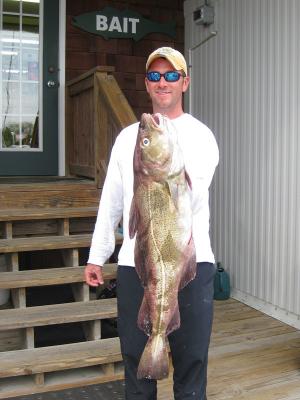Targets have changed to croaker and kings
A great many fishing trips were scrubbed over the weekend as strong north winds had small craft berthed and even gale warnings flying along the coast. The winds subsided on Monday, and fishing began to improve.
The surf continues to give up decent catches, although the primary targets have changed from rock and drum to croaker and kings. The Ferry Jetty in Lewes has been the site of some good catches of croaker and spot with a few trout taken as well. The same is true at Broadkill Beach, Herring Point, Three Rs and Fenwick Island. Bloodworms and clam strips make the best bait.
Roosevelt Inlet is seeing fair numbers of trout on bucktails and jigs. Catches have been made from shore as well as from boats working the rocks and submerged jetty. The jetties at Broadkill Beach have also given up some trout.
The Cape Henlopen Fishing Pier recorded fair numbers of flounder, blues, spot and croaker with bloodworms and Speck Rigs with Gulp! swimming mullet two of the best offerings. Evenings have been the most productive times for flounder.Drum fishing was good prior to the full moon with the Coral Beds the top location to soak a clam. The action continued on Monday as the boats were finally able to return to the bay.
The jetty at Indian River Inlet gave up some impressive rockfish even during the blow, but slowed down later in the week. Shads and bucktails accounted for most of the catch.
Flounder fishing has been disappointing in the Lewes and Rehoboth Canal, Broadkill River and Indian River Bay. Even the most optimistic anglers describe the action as a slow pick. Minnows, shiners, squid and Gulp! have all accounted for a few keepers.
Offshore fishing is showing signs of life. A big bluefin tuna and a small mako shark have been recorded so far, and as the weather improves, I am sure more boats will be making the run to the canyons.
Coastal Conservation Association Delaware Chapter
On Wednesday evening, May 29, a preliminary meeting of the Coastal Conservation Association of Delaware was held at the Grotto Pizza location in Long Neck. Capt. Brian Wazlavek has been in touch with Tony Friedrich, executive director of the CCA of Maryland, and invited him to come to Delaware with the purpose of forming a chapter here.
Wazlavek had done his research and determined the CCA was the most successful group when it came to representing recreational fishermen. With more than 100,000 members in states from Texas to Maine along the Gulf and East Coast and a chapter in Oregon, the CCA is by far the largest and most influential saltwater recreational fishing organization.
In the interest of full disclosure, I was the first executive director of the CCA of Virginia, and beginning in 1989, I was able to establish 10 or 12 chapters from Virginia Beach to Alexandria and even had one in Maryland. We worked to establish a saltwater fishing license in the commonwealth, tried to get a 12-inch minimum size for flounder and attempted to control the menhaden fleet. We were successful in the first two and failed in the third.
Whatever success I had was due to the outstanding volunteers who worked tirelessly to accomplish the goals of the organization. There were 15 or 20 good men and women who helped form chapters, recruited members, put on fundraisers and even established a very successful fishing show. The problems began when these people burned out. Without more volunteers to take their place, the CCA of Virginia began to fail, and it is now a shadow of its former self. In order for the CCA of Delaware to succeed they will need good people to help with the heavy lifting.
Keep in mind that the CCA is a conservation association. Its members put the fish first, and this can ruffle some feathers with commercial, head and charter boat operators. The goal is to put more fish in the water and thereby improve the lot of all recreational and commercial fishermen. The organization strongly supports regulating all fisheries with the goal of protecting the resource. It has worked in every state where the CCA has a presence, beginning in Texas where the first CCA chapter was able to bring the red drum back by passing legislation to protect it from overfishing. The same could be done for weakfish in Delaware.
To find out more about what the CCA of Maryland has accomplished and receive a membership application go to www.ccamd.org. If you are interested in conserving our fisheries, this is the group that can get the job done.


















































